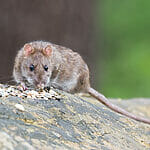The animal kingdom never fails to fascinate us – with such a wide range of animal behaviors, you’ll never get bored of learning about these amazing creatures!

With only their instincts to guide them, animals accomplish some incredible feats, allowing humans to better understand the world around them.
However, these behaviors didn’t suddenly appear overnight, no, they are the result of decades of adaption to survive the particular environment they are in.
Such behaviors include the ability to sleep while standing up; an ability humans aren’t capable of.
With this in mind, we will explore all the different animals that are able to sleep (see also: Animals That Don’t Sleep)while standing up.
Let’s get straight into it!
Why Do Animals Sleep While Standing?
Whether in the wild or captivity, you may have observed an animal that appears the be sleeping while standing up. Sometimes, this can be difficult to determine, however.
That being said, many different animals that different sleeping habits. For instance, in the wild, sleeping while standing is vital for the survival of some animals.
This is because some animals cannot take refuge and hide from predators, especially those living on plains. Hence, sleeping on the ground and then getting back up takes time.
Although, those sleeping while standing up are able to escape much more quickly Sleeping while standing up provides some animals with more security while they rest.
While some animals can sleep standing up, this doesn’t prevent them from sleeping on the ground, either. One example would be the horse.
Horses can sleep while standing up to rest their body and conserve energy. Although, this isn’t considered REM sleep. As they aren’t experiencing deep sleep, they can register their surroundings easier for threats and move swiftly.
However, since this isn’t deep REM sleep, horses may need to sleep on the ground from time to time to achieve this rest.
How Do Animals Sleep Standing Up?
There are various anatomical mechanisms that allow certain animals to sleep while standing up. One of the main factors is the ability to remain upright while sleeping.
Many other animals, including humans, aren’t able to sleep while standing up due to their muscles relaxing while resting.
Horses, in addition to some other animals, can remain uptight when sleeping due to their capability to lock their stifle joint. In certain quadruped animals, this is the joints of the kneecap, tibia, and femur.
Once locked, the animal is able to support itself, even when in a relaxed state.
Another animal that can sleep standing up is the flamingo. However, what is even more impressive is their ability to achieve this with one leg.
Effectively, their legs are locked in place which allows them to carry the center of their body weight – which is helped through their bony articulations found in the joints. Some studies have even shown that standing on one leg helps to preserve energy.
Moreover, this ability appears to ensure reduced calorific expenditure when exposed to low temperatures. Alternatively, in higher temperatures, they can be seen using both legs.
Below, we will explore all the different animals that are able to sleep while standing up.
7 Animals That Sleep While Standing Up
1. Horses
As previously mentioned, while horses can sleep standing up, this doesn’t mean they necessarily do this all the time.
This behavior has long been developed to allow horses to make a quick escape from their predators when sleeping while standing.
Many horses are able to take part in the ‘slow wave’ type of sleeping – which only requires three hours of sleep in 24 hours.
Technically, horses need to be laying down to activate Rapid Eye Movement (REM) sleep. Here, horses lose all muscle tone, and if they were standing, they would simply collapse.
That being said, horses only need approximately 30-40 minutes of REM time in 24 hours. While this may not sound significant, horses who don’t achieve this are more likely to be tired and sleepy during the day.
2. Flamingos
Mammals aren’t the only animals with peculiar sleep behavior, flamingoes, too, make a habit of sleeping standing up.
Flamingoes can be found in caustic salt flats which contain high concentrations of alkaline, protecting them from predators. However, this also makes an uncomfortable environment to lie down in.
As a result, flamingoes evolved to stand and rest on one leg. Not only does this allow them to conserve body heat, but enables them to only keep one foot in the salty marsh.
Moreover, by sleeping and standing up, they minimize the risks of coming into contact with the clumpy salt, plus, they are exerting less effort by using a locking mechanism in their knees.
3. Zebras

Belonging to the horse family, it is no surprise that zebras are able to stand while sleeping, too. These animals can be found in the savannahs of Africa.
While both animals are able to sleep standing up, the reasons behind this are slightly different. For instance, a zebra on the plains will take any opportunity to sleep; although, this will only be done in large groups to ensure they are alerted of danger.
Standing up allows the zebras to pack close up against one another – quickly being notified and escaping if danger were to arise.
4. Giraffes
Within the Serengeti, giraffes could be considered the strangest sleepers. During childhood, these animals tuck their legs beneath their bodies when laying down, then rest their heads on their backs.
Sometimes, adults can be seen taking this position to sleep, too. However, often times they can be seen sleeping while standing, albeit, in shorter time bursts.
During the day, an adult giraffe can accumulate just 30 minutes of sleep. Over decades, many pray animals have adapted and evolved to require less sleep, this is the case for giraffes.
An animal the size of a giraffe laying down in the middle of the plains is a much too tempting snack for predators. Therefore, they rely on as little sleep as possible.
During this time, they often experience half-sleeping periods when standing whereby their eyes remain half-open to detect any predators.
5. Cows
Similar to humans, cows require sleep to remain healthy. However, unlike humans, they require little sleep to achieve this. All in all, cows only require four hours of sleep and dedicate the rest of their day to relaxing and eating.
A common misconception is that cows don’t need to lie down to rest, however, they may nap while standin up.
Per day, cows generally lie down for up to 14 hours. That being said, they take numerous breaks to stretch and lie back down again.
This helps them to digest their food and increases blood circulation which helps with the production of milk.
Still, you can also find cows sleeping while standin up, especially in the sunlight after going for a dip in some water. This is believed to help them conserve energy and keeps them content – similar to how a cat will nap in a sunbeam.
6. Camels

Camels share a sleeping cycle that could be considered slightly more familiar to humans. Here, camels sleep around six hours per day – withstanding extreme temperatures without being bothered.
This is important since their natural environment experiences extreme fluctuations in temperatures. For instance, incredibly hot during the day and freezing cold at the night.
Similar to the other prey animals feaurred on this list, camels have evolved to sleep standing up to evade potential predators at a moment’s notice.
They can achieve this consecutively at night simply due to the fact that most of their predators are protecting themselves from the cold temperatures.
Camels are known for their stubborn tendencies; thus, every time they sleep like resting or having REM sleep, they will simply lie down – here, there is nothing you can do to make them stand up again before they are ready.
7. Elephants
Research has shown that larger animals require less sleep than smaller ones, and this is certainly the case for elephants. On average, elephants sleep only two hours a day.
That being said, they kept in captivity are likely to sleep between four to six hours simply because they don’t have to go out and find food.
Most of the time, elephants sleep while standing. However, on every third or fourth day, they sleep while laying down to achieve REM sleep.
Sometimes, they will even go the entire night without sleeping before finding the optimum conditions to ensure good sleep.
Final Thoughts…
Animals are wonderful creatures, each with unique abilities. For instance, sleeping while standing up. While this may not sound like the most comfortable position for humans, animals can receive all the benefits from sleep in this position.
One of the main reasons animals sleep while standing up is to easily evade the capture of predators. Hopefully, this guide has informed you on animals that sleep while standing up.
Various animals, particularly large ones like horses and certain birds, have evolved unique mechanisms involving tendons, ligaments, and the ankle joint, enabling them to sleep while standing.
This adaptation, often referred to as the ‘stay apparatus,’ allows these animals to snooze securely and quickly awaken if needed.
Horses and birds can sleep on one leg or remain standing due to this system, efficiently managing their sleep which may span for just a few minutes of REM sleep to about two hours per day. This ability is particularly advantageous for herbivores that need to stay alert to potential threats.
- What Should I Do If A Koala Bites Me? Safety Guide - 2024-05-30
- Are Kangaroos Born Without Hind Legs? A Fascinating Journey - 2024-05-30
- Animals That Look Like Squirrels - 2024-05-30









